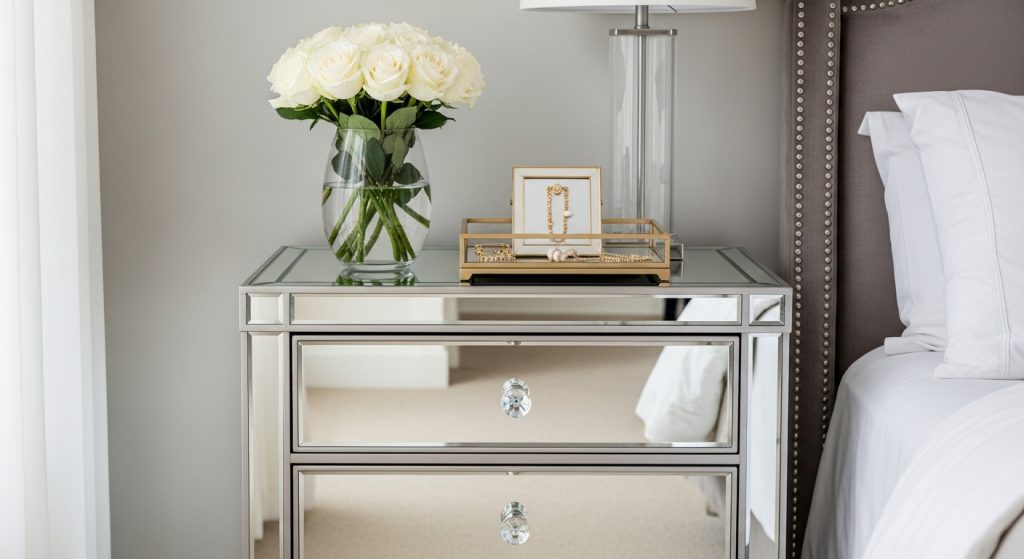This nightstand guide is your definitive resource for selecting the perfect bedside companion. Choosing a nightstand involves more than just picking a small table; it is a crucial decision that impacts your bedroom’s functionality, style, and overall sense of harmony. The right bedside table ideas balance your practical needs with your aesthetic preferences, creating a space that feels both organized and deeply personal. Yet, faced with endless options, many find themselves asking how to choose a nightstand that truly works.

This professional guide provides comprehensive bedroom furniture tips. We will explore the critical factors of function, scale, style, and material. It offers expert advice on achieving perfect matching nightstand decor or mastering the art of intentional mismatching. These insights will empower you to move beyond uncertainty and select a nightstand that is not just a piece of furniture, but a perfectly integrated element of your personal sanctuary.
What is the Fundamental Role of a Nightstand?
The fundamental role of a nightstand is to provide convenient, accessible storage and surface space directly beside the bed. It serves as a home for essential nighttime items like a lamp, alarm clock, phone, water, and books. Beyond its practical function, it also plays a significant aesthetic role, anchoring the bed visually and contributing to the overall style of the bedroom.
A nightstand, sometimes called a bedside table or night table, is a small but mighty piece of furniture. Its history is tied to the evolution of the bedroom itself. Historically, it often held chamber pots or nighttime necessities. Today, its function has adapted to modern needs, primarily serving as a landing spot for technology and personal comfort items. Understanding its dual role—practical servant and stylistic partner—is the first step in choosing wisely.
How Do You Determine Your Functional Needs?
Determining your functional needs requires an honest assessment of what you need to keep within arm’s reach while in bed. Are you a minimalist who only needs a surface for a phone and a lamp? Or do you require significant storage for books, medications, charging devices, and other personal items? Functionality should always be the primary consideration before style.
Thinking through your nightly routine is key. What do you reach for just before sleep or immediately upon waking? Make a list. This practical inventory will directly inform the type and amount of storage you need, guiding you toward the most suitable nightstand design. Ignoring function is one of the most common nightstand buying mistakes to avoid.
What Are the Options for Nightstand Storage?
Nightstands offer a variety of storage configurations to suit different needs.
- Drawers: Offer concealed storage, perfect for keeping clutter out of sight. Ideal for medications, chargers, journals, and personal items. Multiple drawers provide more organization.
- Open Shelves: Provide easy access to items like books, magazines, or decorative baskets. They create a lighter, more open feel but require items to be kept tidy.
- Cabinets: A door conceals a larger storage space, suitable for bulkier items like extra pillows, sleep masks, or medical devices (like a CPAP machine).
- Minimalist Surface: Some nightstands are simply a surface on legs, offering no enclosed storage. This works well for minimalists or in very small spaces.
How Much Surface Area Do You Really Need?
Consider the items that must live on top of the nightstand. You need enough surface area to comfortably accommodate:
- A table lamp (consider its base size).
- An alarm clock or phone charging stand.
- A glass of water.
- Any other essential items like eyeglasses or a book. Measure the footprint of these items. Ensure the nightstand’s top surface is large enough to hold them without feeling cramped or precarious. Overcrowding the surface is a common styling mistake.
Do You Need Built-In Charging Capabilities?
Many modern nightstands now come with built-in charging ports (USB or outlets) or even wireless charging surfaces. Assess whether this feature would genuinely streamline your routine. While convenient, they often come at a higher price point. Consider if a simple power strip hidden behind a traditional nightstand would serve the same purpose more affordably. The demand for integrated technology in furniture is a growing trend.
How Do You Determine the Correct Nightstand Size and Scale?
Determining the correct size and scale is crucial for both function and visual harmony. A nightstand that is too tall, too short, too wide, or too narrow will look awkward and may be uncomfortable to use. The key is to choose a piece that is proportional to your bed and fits comfortably within your bedroom’s layout.
What is the Ideal Height for a Nightstand?
The ideal height for a nightstand is roughly level with the top of your mattress, or perhaps 1-3 inches taller. This allows you to easily reach items on the surface without straining or knocking things over in the dark. A nightstand that is significantly lower or higher than the mattress is impractical and creates an unbalanced look. Our detailed guide, how tall should a nightstand be compared to your bed?, explores this ergonomic principle in depth. Always measure your mattress height (including any toppers) before shopping.
How Wide Should Your Nightstand Be?
The width of your nightstand depends on the size of your bed and the available space on either side.
- Proportion to Bed: A very large bed (King or California King) often looks best with wider nightstands (24-30 inches or more) to feel balanced. A smaller bed (Twin or Full) pairs better with narrower nightstands (18-24 inches).
- Available Space: Measure the space between your bed and any adjacent walls or furniture. Ensure there is enough room for the nightstand plus a few inches of “breathing room” so it doesn’t feel crammed in. A minimum of 2-3 inches on either side is recommended.
How Does Depth Impact Function and Flow?
The depth of the nightstand (front to back) impacts both storage capacity and traffic flow. A deeper nightstand offers more surface area and potentially larger drawers. However, in a smaller room, a very deep nightstand can impede movement around the bed. Consider the walkway space. Ensure there is enough room to comfortably walk past the nightstand without bumping into it.
How Do You Choose a Style That Complements Your Bedroom?
Choosing a style involves deciding whether you want your nightstands to perfectly match your bed and other furniture, or if you prefer a more eclectic, intentionally mismatched look. Both approaches can be successful, but they require different considerations. The goal is a cohesive look that reflects your personal taste.
What Are the Pros and Cons of Matching Nightstands?
Matching nightstands, often purchased as part of a bedroom set, offer several advantages.
- Pros: Creates an instant sense of cohesion and symmetry. Simplifies the shopping process. Ensures materials and finishes are perfectly coordinated. Often provides a traditional, formal look.
- Cons: Can sometimes feel predictable or lack personality. May not offer the specific storage configuration you need. Limits flexibility if you change your bed later.
How to Successfully Mix and Match Nightstands?
Mixing and matching nightstands can create a more curated, designer look, but it requires a careful eye. The key is to create intentional contrast while maintaining visual harmony.
- Find a Unifying Element: The mismatched nightstands should share at least one common element. This could be the color, the material (e.g., both wood, but different styles), the height, or the general style category (e.g., both mid-century modern).
- Vary Form, Not Just Finish: Instead of two identical tables in different colors, consider pairing a table with drawers with a table that has open shelves but a similar finish.
- Consider Visual Weight: Ensure the two different nightstands feel visually balanced. A very heavy, bulky piece on one side should not be paired with a very delicate, leggy piece on the other unless done very intentionally.
- Keep Other Elements Consistent: Use matching lamps or identical accessories on both nightstands to tie the mismatched pieces together.
How Does the Nightstand Style Relate to the Bed Frame?
The nightstand style should relate harmoniously to the bed frame, even if they don’t match perfectly. Consider the overall aesthetic. A rustic wooden bed frame pairs well with nightstands made from reclaimed wood or distressed finishes. A sleek, upholstered platform bed looks great with modern, clean-lined nightstands in lacquer or metal. An ornate, traditional bed calls for equally detailed and substantial nightstands. The goal is a pairing that feels complementary, not jarring.
What Are the Best Materials for Durability and Style?
The material of your nightstand significantly impacts its durability, style, and maintenance requirements. Different materials offer distinct aesthetic qualities and practical benefits. Choosing the right material involves balancing your style preferences with your lifestyle and budget. Our guide to the best nightstand materials for durability and style provides a deep dive.
Why is Solid Wood a Timeless and Durable Choice?
Solid wood is a timeless choice known for its durability, natural beauty, and longevity. Woods like oak, walnut, maple, and cherry offer strength and a rich character that develops over time. A solid wood nightstand can withstand daily use and can often be refinished if needed. Its natural warmth complements almost any design style. The investment in solid wood furniture often pays off in its lasting quality.
What Are the Pros and Cons of Wood Veneers and MDF?
Wood veneers (a thin layer of real wood bonded to a core material like MDF or particleboard) and MDF (Medium Density Fiberboard) offer more budget-friendly alternatives to solid wood.
- Pros: Can achieve a similar look to solid wood at a lower cost. Veneers offer consistent grain patterns. MDF provides a smooth surface perfect for painted finishes.
- Cons: Less durable than solid wood. Veneers can chip or peel. MDF can be susceptible to water damage if the finish is compromised. Repairs are more difficult.
How Do Metal Nightstands Add a Modern or Industrial Edge?
Metal nightstands, often made from steel, aluminum, brass, or nickel, can add a sleek, modern, or industrial touch. Polished finishes offer glamour, while matte black or aged bronze provides an industrial feel. Metal is very durable and easy to clean. However, it can sometimes feel cold compared to wood. Combining a metal frame with wood or glass elements is a popular way to balance the look. The trend of using mixed materials in furniture is significant.
What is the Appeal of Glass and Mirrored Nightstands?
Glass and mirrored nightstands offer a light, airy, and glamorous aesthetic. They reflect light, making the bedroom feel larger and brighter. Mirrored nightstands, in particular, add a touch of Hollywood Regency style. However, these materials require more frequent cleaning to maintain their sparkle, as they show fingerprints and dust easily. They can also be more fragile than wood or metal.
What About Upholstered or Lacquered Finishes?
Upholstered nightstands, covered in fabric or leather, add a soft, luxurious texture to the bedroom. They are often used in contemporary or glamorous design schemes. Lacquered nightstands offer a high-gloss, sleek, and modern finish. They come in a wide range of colors, from classic black and white to bold, vibrant hues. Both require careful maintenance to prevent stains or scratches on their delicate surfaces.
How Do You Style Your Nightstand Like a Pro?
Styling your nightstand is the final step in creating a beautiful and functional bedside vignette. The goal is a curated, uncluttered look that balances practical needs with personal style. Follow the professional principles of layering, varying heights, and incorporating texture.
How to Apply the “Rule of Three” for Accessories?
The “Rule of Three” is a classic styling guideline suggesting that objects grouped in odd numbers are more visually appealing. For a nightstand, this often translates to a trio of key items:
- Something Tall: Usually a table lamp.
- Something Medium/Functional: An alarm clock, a small stack of books, or a decorative box.
- Something Small/Personal: A framed photo, a small plant, or a candle. Arranging these items in a loose triangle creates a balanced and dynamic composition.
Why is Varying Height So Important?
Varying the height of your accessories is crucial for creating visual interest. If everything is the same height, the display looks flat and static. The lamp typically provides the main vertical element. Use books to elevate smaller objects. Choose accessories of different inherent heights (like a tall vase versus a low bowl). This “skyline” effect guides the eye and feels more natural.
How to Incorporate Texture and Natural Elements?
Incorporate texture to add warmth and depth. This is especially important if your nightstand has a very smooth or hard finish. Consider:
- A Small Plant: Adds an organic shape and a touch of life.
- A Woven Coaster: Protects the surface and adds natural texture.
- A Stack of Books: Provides a soft, paper texture.
- A Ceramic Bowl: Offers an earthy, matte contrast.
- A Linen Lampshade: Adds softness. This mix of textures makes the vignette feel more layered and inviting.
How to Manage Cords and Clutter?
Managing cords and clutter is essential for a serene bedside environment.
- Use Cord Clips or Ties: Bundle lamp and charger cords together and run them discreetly down the back leg of the nightstand.
- Utilize Drawer Organizers: Keep the contents of your drawers tidy with small dividers or boxes.
- Employ a Catch-All Tray: Use a small, attractive tray or bowl on the surface to corral loose items like lip balm, jewelry, or reading glasses. This commitment to organization is key to maintaining a calm and restful atmosphere.
Conclusion
This nightstand guide demonstrates that choosing the perfect bedside table is a thoughtful process. It requires a careful balance of practical function, appropriate scale, harmonious style, and durable materials. By analyzing your needs, measuring your space, considering your bed’s style, and selecting high-quality materials, you can find a nightstand that truly serves you. Following professional bedroom furniture tips for styling ensures your final choice becomes a beautiful, functional, and perfectly integrated part of your personal sanctuary. It is more than just furniture; it is your perfect bedside partner.











